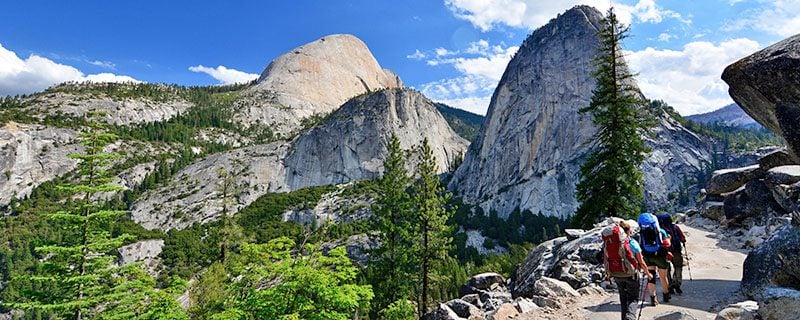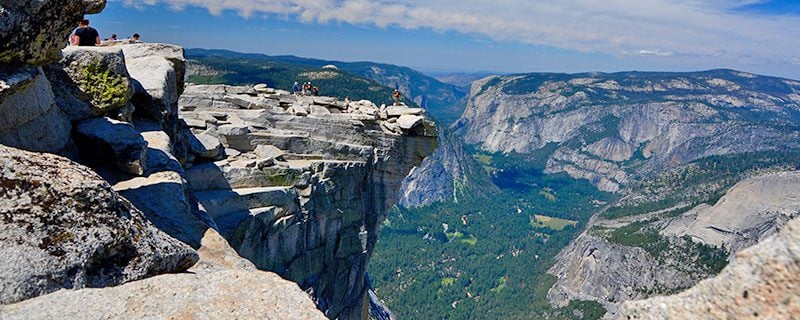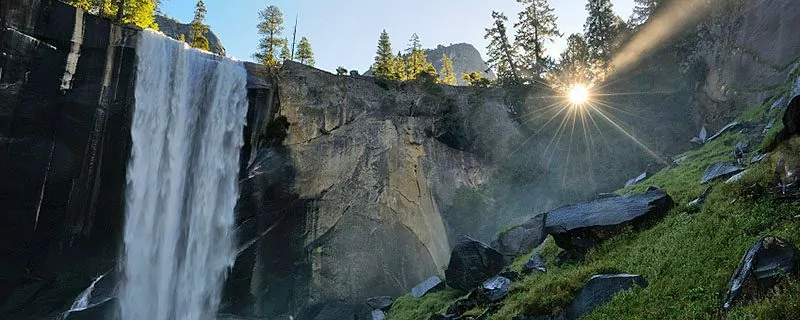
Half Dome Trail
Getting to the summit of Half Dome is a “Bucket List” experience for a lot of folks. This can be done in a really long day or over the course of multiple days. There is no “Half Dome Trail” the dome is most accessible via the John Muir Trail from the North in Tuolumne Meadows or South in Yosemite Valley. Once you make your way down either you will find a junction that heads west toward the summit of the dome. Either way you slice it the trek involves an arduous hike to access the trail junction to the dome, then you still have 2 miles to go with an 1800 ft climb including the 400 ft section of cables. These cables are put in place so you can access the top of the dome without any special climbing gear. Making it to the top of Half Dome rewards the hiker with unparalleled views of the Valley down below, not to mention you can brag to your friends that you made it to the top of Half Dome.
History of Half Dome
Half Dome is probably the most famous Granite Monolith in the world. A monolith, to me and you, is basically a large single piece of stone or rock. The dome was formed about 65 million years ago along with the rest of the Serra Nevada, molten rock formed under ground and then through the process of subduction pushed up above the earths surface. The now exposed Granite was shaped into domes as curved shaped joints called “sheeting joints” were cleaved off, over time. Along with Sheeting joints, Vertical shaped joints were present in Half Dome’s north face. As glacier’s moved past these joints, sections of rock were pulled off exposing a flat vertical face that appears to have been cut in half. Depending on the angle you view the dome it can appear to be a very full as seen on the far left in the picture below.

Best Day Hikes on the Half Dome Trail
The best way to get to the top of Half Dome in one day is via the John Muir trail from Yosemite Valley. Hands down this is the most efficient way to do it if you only have a day to get to the top. Our recommendation is to start super early in the morning so you have all day to get there and back.
Below are the primary options for day hiking the John Muir (Half Dome) Trail:
| Destination | Miles | Elev | Difficulty | Style | |
| Yosemite Valley to Half Dome | 14.8 | 4,800 ft | Strenuous | Out and Back | |
1. Yosemite Valley to Half Dome
Hiking from Yosemite Valley to the top of Half Dome is a difficult task to do in one day but if you are up for the challenge then the reward is worth it. This strenuous hike begins and ends in Half Dome village, Yosemite Valley. Follow the Southside drive southeast past the campgrounds toward Happy Isles. Cross the bridge over the Merced river and take a hard right turn, you will see a brown sign pointing toward the John Muir Trail. The trail starts out flat for less than a 1/4 mile and then begins a tough accent up a paved trail toward the Vernal Falls footbridge. Once you reach the footbridge after about 1.5 miles you’ll get your first view of Vernal Falls. After another mile and 1000ft climb you reach the top of Vernal Falls. From the top of Vernal falls follow the Mist Trail past the Emerald Pool for another 1000 ft accent up to the top of Nevada Falls. Once you reach the top of the accent take a left turn past the pit toilets. After a moderate 1.5 mile hike you will reach the camp at Little Yosemite Valley. Follow the trail northeast to the junction of the trail that heads up to Half Dome. From Here you have a roughly 2 mile hike up steep switchbacks to whats known as the “sub dome” or the smaller dome just before the top of Half Dome. This where where you will be confronted with the famous 400ft stretch of cables. Our suggestion is to bring gloves for this part, they can be rough not he hands. Head up the cables and you have reached the top of the dome!! Enjoy the views and simply retrace your steps to head back down to Yosemite Valley.
Maximize Your Visit to Yosemite on a Hiking Tour
Guided day hike tours and multi-day packages allow visitors the opportunity to make the most of their time in Yosemite National Park and to do it hassle-free. Guided tours include gear (backpack, trekking poles, crampons in winter), meals, accommodations on multi-day tours, local transportation, and a professional Yosemite hiking guide. Through their knowledge, stories, and personal passion, guides can bring a place to life in a way that’s much more difficult to do on your own. Read more about Yosemite Hiking Tours.

3 Half Dome Backpacking Trips
If you have a couple of days then consider backpacking to the top of Half Dome vs trying to do it all in one day. That way you can break up your hike a bit and take the time to enjoy it. Of course, you will have to make sure you have any necessary permits to camp as well as climb the cables to the top of the dome. See the “necessary permits” section below for more information. Here are our recommendations for the best trails to backpack to Half Dome.
| Route | Miles | Difficulty | Campgrounds | |
| Yosemite Valley to Half Dome | 14.8 mi | Strenuous | Little Yosemite Valley | |
| Tuolumne Meadows to Half Dome | 32.2 mi | Strenuous | Sunrise, Little Yosemite Valley | |
| Yosemite Valley- Half Dome- Tuolumne | 21.5 mi | Strenuous | Sunrise, Little Yosemite Valley |
1. Yosemite Valley to Half Dome (2-3 days)
This strenuous hike begins and ends in Half Dome village, Yosemite Valley. Follow the Southside drive southeast past the campgrounds toward Happy Isles. Cross the bridge over the Merced river and take a hard right turn, you will see a brown sign pointing toward the John Muir Trail. The trail starts out flat for less than a 1/4 mile and then begins a tough accent up a paved trail toward the Vernal Falls footbridge. Once you reach the footbridge after about 1.5 miles you’ll get your first view of Vernal Falls. After another mile and 1000ft climb you reach the top of Vernal Falls. From the top of Vernal falls follow the Mist Trail past the Emerald Pool for another 1000 ft accent up to the top of Nevada Falls. Once you reach the top of the accent take a left turn past the pit toilets. After a moderate 1.5 mile hike you will reach the camp at Little Yosemite Valley. Set up camp for 1-2 nights and make way toward the dome the next morning. Again, we recommenced and early start up toward the dome. Follow the trail northeast to the junction of the trail that heads up to Half Dome. From Here you have a roughly 2 mile hike up steep switchbacks to whats known as the “sub dome” or the smaller dome just before the top of Half Dome. This where where you will be confronted with the famous 400ft stretch of cables. Our suggestion is to bring gloves for this part, they can be rough not he hands. Head up the cables and you have reached the top of the dome!! Enjoy the views and simply retrace your steps to head back down to Yosemite Valley.
2. Tuolumne Meadows to Half Dome and back (4-5 days)
This is the longest and hardest way to reach the top of Half Dome. The trek starts at the Visitor’s center in Tuolumne meadows. You will hop on the John Muir trail and head south toward Cathedral Lakes. After a little over 6 miles you’ll reach the beautiful Sunrise camp. We recommend setting up camp here for the evening and enjoying the view. The next day pack up and keep heading south on the JMT. Your goal is to reach the camp at Little Yosemite Valley. This is your basecamp for summiting Half Dome the next day. An early wake up takes you northeast to the junction of the trail that heads up to Half Dome. From Here you have a roughly 2 mile hike up steep switchbacks to whats known as the “sub dome” or the smaller dome just before the top of Half Dome. This where where you will be confronted with the famous 400ft stretch of cables. Our suggestion is to bring gloves for this part, they can be rough not he hands. Head up the cables and you have reached the top of the dome!! Head back the same way toward your camp at LYV. From here it is up to you, pack up and head out or stay the night. We recommend heading back the way you came for another nights stay at Sunrise to break up the trip. Ultimately, your end goal is to get back to where you started at the Tuolumne visitor’s center.
3. Yosemite Valley to Tuolumne with Half Dome (3-4 days)
This is a great way to experience 2 different sections of the park all while getting to the top of Half Dome. This backpacking trip is by far one of the best in Yosemite. Your trip starts at Half Dome Village in Yosemite Valley. You will start by climbing up the John Muir Trail past Vernal and Nevada falls. This is a 2000ft accent sure to get the legs warmed up. Once you hit the top of Nevada falls stop to take in the view down below and then head northeast along the Merced River toward your first campsite at Little Yosemite Valley. From Here you have a roughly 2 mile hike up steep switchbacks to whats known as the “sub dome” or the smaller dome just before the top of Half Dome. This where where you will be confronted with the famous 400ft stretch of cables. Our suggestion is to bring gloves for this part, they can be rough not he hands. Head up the cables and you have reached the top of the dome!! Your next day is just as strenuous as the first, another 2000ft climb along Sunrise creek toward the aptly named Sunrise campground. Be sure to wake up early and catch the amazing sunrise that gives this area it’s name. Today you only have about 5 miles to hike and its mostly down hill. Once you get to Tuolumne Meadows head toward the backpackers camp behind the Tuolumne Meadows campground and settle in for a hot meal and some cold drinks. From there your going to have to hop on the YARTS bus to get back to your car at Yosemite Valley. Its super easy to do and the bus stop is right by the campground at the grocery store. For some info about that shuttle click here. Cheers to an amazing backpacking trip in Yosemite!
Join a Guided Yosemite Backpacking Trip
Joining a Yosemite backpacking tour is a worry-free, adventurous way to experience Yosemite. With your gear, meals, local transportation, permits, and fees taken care of for you, you can travel light and focus 100% on enjoying the hiking experience, while the guide company takes care of everything else. Also, by going with local experts you’ll enjoy a greater level of safety and gain a much better understanding of the history, ecology and uniqueness of the region. Read more about a guided Yosemite backpacking trips.

When to Hike and Seasonal Considerations
The best time to visit Yosemite National Park is anytime. The month’s of May-Oct are ideal for weather. The days can be hot (70-90F) with cool nights (40-50F). There is little rain in the summer months although the Sierra Nevada is known for unpredictable weather so best to always be prepared. Winter is cold and temps during the day can range from 10-30 degrees F. Sierra Nevada translates to the “Snowy Range” in Spanish, so you can expect there to be snow if visiting in wintertime. Despite the cold and the wet, winter is a lot quieter than the busy summer months with a lot less people. For information on Yosemite National Park weather, click here
Keep in mind the cables on Half Dome usually go up around May and come down in October. Plan your trip accordingly.
Necessary Permits
Day Hike Permits
You do not need a permit to Day Hike in Yosemite National Park. However, you do need a permit to climb the cables on Half Dome. For info click here.
Backpacking Permits
You will need to secure a permit to backpack in Yosemite National Park. Permits are reservable 6 months in advance to the date you wish to start hiking. You can also try and secure a permit the day before your trek in person at any wilderness permit center before 11 am. See more information about Yosemite’s permit system.
You will also need to secure a Half Dome permit in addition to your backcountry permit. For info on that permit click here.
Getting to the Half Dome Trailhead
There are two access points of the John Muir Trail in Yosemite National Park, one is in Yosemite Valley and the other in Tuolumne Meadows. Public transportation is available into Yosemite National Park via the YARTS bus. For info on the YARTS bus, click here
To access the JMT via Yosemite Valley you have to start in Half Dome Village. Getting to Half Dome village is pretty easy if you have a vehicle, once you get into the park follow signs toward “Yosemite Valley Destinations” and then Half Dome Village. If your coming into the Valley via YARTS, you will be dropped off at Half Dome Village. Once you get to the Village walk southeast along Southside drive past the campgrounds and follow signs toward the John Muir Trail. You will cross over the Merced river just past the Happy Isles Nature Center and bathrooms. For a map of Yosemite valley trailheads including the JMT, click here
To access the JMT via Tuolumne Meadows start at the Visitor’s Center. You can also access the trail from the Wilderness Center/Ranger Station. You can park at both locations for free and the trail starts right out of the parking lot. If your coming in Via YARTS bus, you will be dropped off at the Visitor’s center and can start the trail from there. For a map of Yosemite trailheads including JMT via Tuolumne Meadows, click here
Suggested Packing List
Day Hike Packing List
- 3-6 liters of water (more in summer)
- Salty, calorie-rich snacks
- lunch
- backpack
- trekking poles
- crampons (in winter)
- wide-brimmed hat
- sunscreen, sunglasses
- cotton t-shirt (spring-fall)
- non-cotton t-shirt (winter)
- rain jacket
- warm non-cotton layer
- 1st-aid kit
Backpacking Packing List
- all items listed for day hikes PLUS
- multi-day backpack
- 3-season tent
- sleeping bag
- sleeping pad
- backpacking stove and fuel
- backpacking meals
- 3 pairs wool socks
- extra t-shirts
- water filter or water treatment tablets
Please Respect Our National Parks – Leave No Trace
We strongly recommend abiding by all Leave No Trace ethics guidelines and practices so that our national parks and public lands are preserved for the enjoyment of future generations and for the people and animals who call these places home. Simple things like packing out your trash, obeying national park rules, and respecting the peace and quiet of our national park trails is a great start. If you’re going on a backpacking trip, you can read about more about the 7 Leave No Trace Principles.




